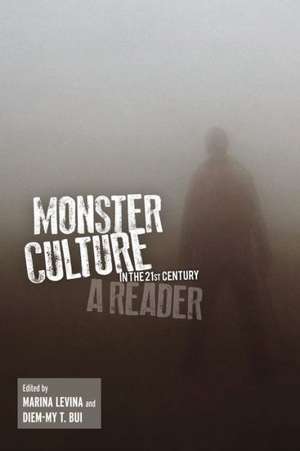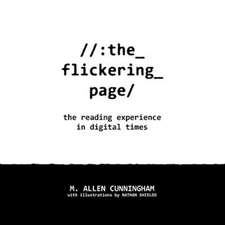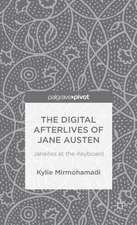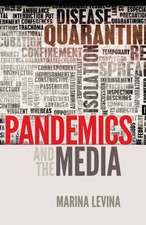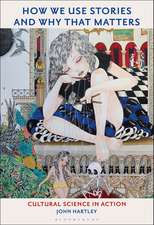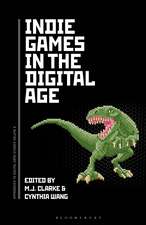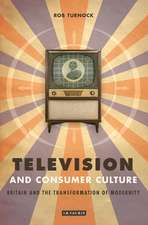Monster Culture in the 21st Century: A Reader
Editat de Marina Levina, Diem-My T. Buien Limba Engleză Paperback – 17 iul 2013
Preț: 260.25 lei
Preț vechi: 296.82 lei
-12% Nou
Puncte Express: 390
Preț estimativ în valută:
49.80€ • 52.13$ • 41.45£
49.80€ • 52.13$ • 41.45£
Carte tipărită la comandă
Livrare economică 31 martie-14 aprilie
Preluare comenzi: 021 569.72.76
Specificații
ISBN-13: 9781441178398
ISBN-10: 1441178392
Pagini: 344
Ilustrații: 20
Dimensiuni: 152 x 229 x 36 mm
Greutate: 0.5 kg
Editura: Bloomsbury Publishing
Colecția Bloomsbury Academic
Locul publicării:New York, United States
ISBN-10: 1441178392
Pagini: 344
Ilustrații: 20
Dimensiuni: 152 x 229 x 36 mm
Greutate: 0.5 kg
Editura: Bloomsbury Publishing
Colecția Bloomsbury Academic
Locul publicării:New York, United States
Caracteristici
Featuring international scholars, the collection illustrates that monstrous discourses and representations have global significance.
Notă biografică
Marina Levina is an Assistant Professor at the Department of Communication at the University of Memphis, US.Diem-My T. Bui is a Visiting Assistant Professor in the Department of Communication at the University of Illinois Chicago, US.
Cuprins
Introduction: Toward a Comprehensive Monster Theory in the 21st Century by Marina Levina and Diem My Bui1. Ontology and Monstrosity by Amit S. RaiPart I: Monstrous Identities 2. Heading Towards the Past: The Twilight Vampire Figure as Surveillance Metaphor by Florian Grandena3. Playing Alien in Post-Racial Times by Susana Loza4. Battling Monsters and Becoming Monstrous: Human Devolution in The Walking Dead by Kyle W. Bishop5. The Monster in the Mirror: Reflecting and Deflecting the Mobility of Gendered Violence Onscreen by Megan Foley6. Intersectionality Bites: Metaphors of Race and Sexuality in HBO's True Blood by Peter Campbell7. Gendering the Monster Within: Biological Essentialism, Sexual Difference, and Changing Symbolic Functions of the Monster in Popular Werewolf Texts by Rosalind SibielskiPart II: Monstrous Technologies 8. Abject Posthumanism: Neoliberalism, Biopolitics and Zombies by Sherryl Vint 9. Monstrous Technologies and the Telepathology of Everyday Life by Jeremy Biles10. Monstrous Citizenships: Coercion, Submission, and the Possibilities of Resistance in Never Let Me Go and Cloud Atlas by Roy Osamu Kamada11. On the Frontlines of the Zombie War in the Congo: Digital Technology, the Trade in Conflict Minerals, and Zombification by Jeffrey W. Mantz12. Monsters by the Numbers: Controlling Monstrosity in Video Games by Jaroslav Svelch13. Killing Whiteness:The Critical Positioning of Zombie Walk Brides in Internet Settings by Michele WhitePart III: Monstrous Territories 14. Zombinations: Reading the undead as debt and guilt in the national imaginary by Michael S. Drake15. The Monster Within: Post-9/11 Narratives of Threat and the U.S. Shifting Terrain of Terror by Mary K. Bloodsworth-Lugo and Carmen R. Lugo-Lugo16. The Heartland Under Siege: Undead in the West by Cynthia J. Miller and A. Bowdoin Van Riper17. When Matter Becomes an Active Agent: The Incorporeal Monstrosity of Threat in Lost by Enrica Picarelli18. Monstrous Capital: Frankenstein Derivatives, Financial Wizards, and the Spectral Economy by Ryan Gillespie19. Domesticating the Monstrous in the Globalizing World by Carolyn HarfordAbout the Contributors Index
Recenzii
The essays in this new edited collection are . . . designed to address how monstrosity has come to represent the fears that the new century has brought with it. [...] The book does itself an injustice by calling itself a "reader" when, in fact, it is more than just a collection of articles bundled together . . . The editors have clearly worked hard to present a collection of essays in such a way that the book has a through-narrative, and for that they should be congratulated.
Preoccupied with zombies, vampires, and ever more unholy configurations of human body parts and consciousnesses, the 21st century is proving to be a monstrous time. Monster Culture in the 21st Century offers readers an international and interdisciplinary theoretical toolkit that can help us better understand the monstrous' magical ability to reflect and refract immense political, technoscientific, and ecological changes and anxieties.
Monster Culture in the 21st Century brings together various theoretical and methodological approaches to look critically at the trope of the monstrous as an increasingly ubiquitous mode for managing contemporary crises of identity, technology and globalization through popular media culture. As such it provides refreshing new directions for understanding 'monster culture' beyond metaphor and as a necessary condition of our lives in the 21st century.
Monster Culture in the 21st Century stands out prominently among the wave of . . . new post-millennial studies . . . [It] succeeds as both a research guide and a classroom tool, in large part due to its expansive scope and, yet also, the unusual particular care given to its myriad topics
Preoccupied with zombies, vampires, and ever more unholy configurations of human body parts and consciousnesses, the 21st century is proving to be a monstrous time. Monster Culture in the 21st Century offers readers an international and interdisciplinary theoretical toolkit that can help us better understand the monstrous' magical ability to reflect and refract immense political, technoscientific, and ecological changes and anxieties.
Monster Culture in the 21st Century brings together various theoretical and methodological approaches to look critically at the trope of the monstrous as an increasingly ubiquitous mode for managing contemporary crises of identity, technology and globalization through popular media culture. As such it provides refreshing new directions for understanding 'monster culture' beyond metaphor and as a necessary condition of our lives in the 21st century.
Monster Culture in the 21st Century stands out prominently among the wave of . . . new post-millennial studies . . . [It] succeeds as both a research guide and a classroom tool, in large part due to its expansive scope and, yet also, the unusual particular care given to its myriad topics
